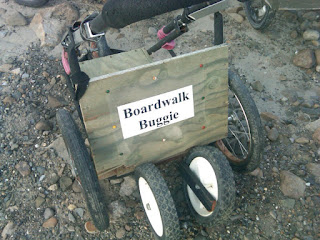Our first two days in Nome consisted of warm temperatures
and clear skies. Today's forecast shows no change in temperature, but a
possible chance of rain in the afternoon. Weather in Alaska, particularly along
the coast, is hard to predict so we left Nome prepared for whatever conditions
Mother Nature had in store for us. We knew that mosquitoes would be part of the
forecast, that we could definitely count on!
Our group got together last night and looked over a
series of satellite images that Santonu had prepared and brought with him.
After some discussion, it was decided that we would visit a more recent drained
thaw lake basin along the Kougarok Road. The lake basins we worked at earlier
in the week were, according to Guido, several thousand years old. The basin
that we had picked out for today was much younger; in aerial images it showed
up as a wetland in the 1950s, a lake in the 1970's, and then drained just
within the last 5 years. This meant that it was a good analog for what might be
expected in a changing climate. That is, a landscape in transition at time scales
relevant for inclusion in climate models.
We arrived at the site mid-morning and went about our
routine. Jenny and Guido quickly set up the GPS base station, while the rest of
us walked a short distance across the tundra to the basin of interest. What we
found was a basin 150 to 200 meters in diameter. The basin was 5 to 10 meters below
that of the surrounding tundra. Guido mentioned that the lake most likely
drained when the down-slope rim for the basin was breached by high water and
set-up conditions favorable for thermal erosion. Indeed, when we walked down to
that area, there was strong evidence of a deep thermal gully running out into
the tundra. The basin itself was dotted with small ponds several meters in
diameter and large rounded mounds that were rich in peat. These mounds were
exceptionally dry and plant mortality was severe. In some cases, large areas
were completely lacking live vegetation. This was similar to what we see in
terms of vegetation dynamics on high-centered polygons in Barrow.
As we had in previous days ,we laid out transects and
began collecting data. Guido was curious about the ponds within this basin and
started mapping their location. Although polygonal structures within the basin
were only weakly visible, the ponds to my eye were mostly in trough
intersections. Guido probed a little to determine their depth and they were
maybe on average a meter deep. However, in one there was a much deeper area
that ran lengthwise across the pond, leading Guido to speculate that this could
be an area were the underlying ice-wedge had melted. In some cases the water
was actively running through these areas and in others the ponds were static.
In the latter case, the water was 13 to 15C, warm enough to certainly contribute
to a deepening or expansion of these ponds. The surface and subsurface
interactions are undoubtedly strong in these young and changing drained thaw
lake basins. Since our team has such a good geophysical characterization
capability, this is something that we are interested in pursuing further.
Having worked hard, we left the field today very
satisfied with what we had seen and accomplished. It did rain, but not enough
to stop our work for very long. The topic of discussion over dinner was whether
we could locate any more of the young basins along either the Kougarok or
Council Roads out of Nome. Guido, Dan, and Santonu were going to take a more
extensive look at their maps and see. Last year, we saw small drained lake
basins out the road to Council and Larry Hinzman, Chief Scientist for the NGEE
Arctic project, has studied several "disappearing lakes" in this
region over the last decade. Whether these lakes drain due to surface water
drainage in continuous permafrost like the one we saw today or more subtle
connection to groundwater in areas of discontinuous permafrost like Council
would be an interesting research question. If such features become more
prevalent in the future because of regional warming, then they represent
processes that could be incorporated into climate models for improved
predictions. This is, of course, the goal of our project.
























































